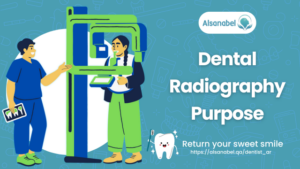When it comes to dental health, seeing the bigger picture is crucial. Dental X-rays play a vital role in allowing dentists to uncover hidden issues within the oral cavity, providing a comprehensive view of not just the teeth but also the roots, gums, and bone structure. In this blog post, we delve into the importance of dental radiography in dentistry, shedding light on how these diagnostic tools are essential in detecting abnormalities, structural irregularities, and areas of decay that may go unnoticed by the naked eye. So, let’s dive into the world of dental X-rays and understand why they are a key component of optimal oral health.
Table of Contents
ToggleDental Radiography Purpose
Dental radiography, also known as dental X-rays, serves several important purposes in dentistry at dental center Qatar:

- Diagnosis: Dental X-rays allow dentists to detect and diagnose various oral health conditions that may not be visible during a clinical examination alone. This includes identifying dental caries (cavities), periodontal disease, infections, tumors, cysts, and abnormalities in tooth structure or alignment.
- Treatment Planning: Radiographs help dentists plan and determine appropriate treatment strategies for their patients. By providing detailed images of the teeth, roots, and surrounding bone structures, X-rays aid in developing treatment plans for restorative procedures, orthodontic treatment, oral surgery, and dental implants.
- Monitoring Oral Health: Dental X-rays are valuable for monitoring changes in oral health over time. Regular radiographic examinations can track the progression of dental conditions, evaluate the effectiveness of treatments, and detect any new issues that may arise.
- Preventive Care: X-rays play a role in preventive dentistry by enabling early detection of dental problems before they become symptomatic or more severe. Identifying and addressing issues at an early stage can help prevent further damage and preserve oral health.
- Patient Education: Dentists use X-rays as visual aids to educate patients about their oral health status, treatment options, and the importance of preventive care. Seeing radiographic images can help patients better understand their dental conditions and make informed decisions about their oral health care.
Types of Dental Radiographs
Dental radiography encompasses various types of X-rays, each serving specific diagnostic purposes:
- Bitewing X-rays: Reveal upper and lower teeth in a single section, ideal for cavity detection between teeth and assessing dental restorations.
- Periapical X-rays: Capture images of individual teeth from crown to root, aiding in diagnosing abscesses, infections, and tooth abnormalities.
- Panoramic X-rays: Offer a broad view of the entire mouth, facilitating assessments of dental and skeletal health, impacted teeth, and orthodontic planning.
- Occlusal X-rays: Provide images of full dental arches, useful in tracking children’s tooth development, identifying abnormalities, and assessing trauma.
- Cone Beam Computed Tomography (CBCT): Offers detailed 3D images for complex procedures like implant placement, orthognathic surgery, and oral pathology diagnosis.
Each type serves unique diagnostic needs, allowing dentists to develop personalized treatment plans for patients’ oral health at best dental clinic in Qatar.
Benefits of Dental Radiography
Dental radiography, or X-rays, offers numerous benefits in the field of dentistry at best dental clinic in Qatar:
- Early Detection of Dental Problems: X-rays allow dentists to detect dental issues at their earliest stages, often before they are visible to the naked eye. This early detection enables prompt intervention, preventing the progression of dental problems and minimizing the need for more invasive treatments.
- Accurate Diagnosis: Radiographs provide detailed images of the teeth, supporting structures, and surrounding tissues, allowing dentists to accurately diagnose a wide range of dental conditions, including cavities, infections, periodontal disease, and abnormalities in tooth development or alignment.
- Comprehensive Treatment Planning: With the information obtained from X-rays, dentists can develop comprehensive treatment plans tailored to the individual needs of each patient. Radiographs help dentists determine the most appropriate treatment options and establish priorities for addressing dental issues effectively.
- Monitoring Oral Health: Regular dental X-rays enable dentists to monitor changes in a patient’s oral health over time. By comparing current radiographs with previous ones, dentists can track the progression of dental conditions, evaluate the effectiveness of treatments, and identify any new or developing issues.
- Guidance for Dental Procedures: X-rays provide valuable guidance during various dental procedures, such as tooth extractions, root canal therapy, dental implant placement, and orthodontic treatment. They help dentists visualize anatomical structures, assess bone density and quality, and ensure precise treatment delivery.
- Patient Education: Radiographs serve as visual aids for patient education, helping dentists explain dental conditions, treatment options, and the importance of preventive care to patients. Seeing their own X-ray images can empower patients to take an active role in their oral health and make informed decisions about their dental care.
- Improved Patient Safety: Advances in dental radiography technology have led to the development of digital X-ray systems, which produce lower radiation doses compared to traditional film-based X-rays. Digital radiography enhances patient safety while still providing high-quality diagnostic images.
Equipment Used in Dental Radiography
Dental radiography relies on specialized equipment to capture X-ray images of teeth and surrounding structures:
- X-ray Machine: Generates X-ray photons for imaging, available in various types for flexibility.
- X-ray Tubehead: Produces X-rays, containing a tube, collimator, and filters for beam control.
- Positioning Devices: Ensure accurate placement of X-ray film or digital sensors in the mouth for optimal imaging.
- X-ray Film or Digital Sensors: Capture X-ray images; traditional film or digital sensors transfer images to a computer for analysis.
- Image Processing Systems: Software and hardware for acquiring, processing, and displaying digital X-ray images, enhancing diagnostic quality.
- Protective Equipment: Lead aprons, thyroid collars, and barriers shield individuals from radiation exposure during procedures.
- Quality Assurance Tools: Monitor and maintain equipment accuracy and consistency for reliable image quality and diagnostics.
These components work together to acquire high-quality dental radiographs, aiding dentists at dental center Qatar in accurate diagnosis, treatment planning, and monitoring of oral health.
Advancements in Dental Radiography
Advancements in dental radiography have revolutionized diagnostic capabilities, patient comfort, and safety:

- Digital Radiography: Digital sensors capture X-ray images, offering faster acquisition, reduced radiation exposure, and enhanced diagnostic clarity through image manipulation.
- Cone Beam Computed Tomography (CBCT): Provides detailed 3D images for complex procedures, aiding in implant placement, orthodontic planning, and oral pathology evaluation.
- Portable X-ray Units: Compact, battery-operated units enable chairside X-ray imaging, enhancing convenience in various clinical settings.
- Digital Panoramic Imaging: Offers high-resolution panoramic images with reduced radiation exposure, aiding in comprehensive oral assessments.
- Image Processing Software: Allows manipulation and enhancement of digital X-ray images for improved diagnostic accuracy and treatment planning.
- Reduced Radiation Exposure: Technological advancements have led to lower radiation doses, ensuring patient safety without compromising image quality.
- Artificial Intelligence (AI) Integration: AI algorithms assist in image interpretation, lesion detection, and diagnosis, enhancing efficiency and accuracy in dental radiography.
Thank you for reading our blog on the importance of dental radiography in dentistry. We hope you found the information valuable and informative. If you have any questions or would like to share your thoughts on this topic, please feel free to leave a comment below. Your feedback is always appreciated. Stay tuned for more insightful articles on dental health and advancements in dentistry. Thank you for being a part of our community!
